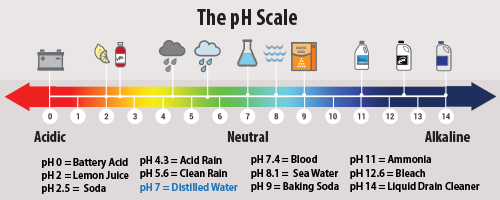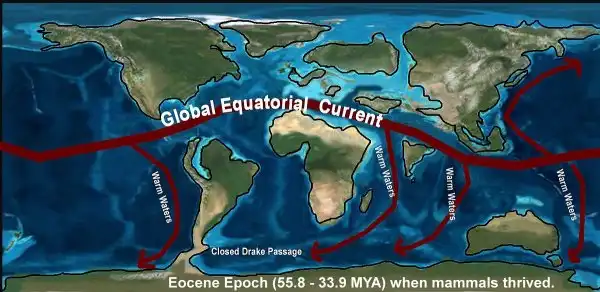Ocean Currents, Climate, Ocean pH
by Lewis Loflin
Follow @Lewis90068157
Several naturally occurring, unpredictable, uncontrollable, and somewhat cyclical factors control climate. The oceans, by shear mass, control global heat flow along with orbital shifts and plate tectonics.
Ocean currents are determined by the positions of land masses.
During the Cambrian Explosion (541 to 485.4 MYA), when complex life exploded onto the scene (including corals, etc.), the atmosphere may have been as high as 10,000 PPM CO2 as opposed to ~400 PPM today. The oceans were not fatally "acid," and life did just fine. The fact we are here proves that.
Rising seas also eroded more shoreline, That, in turn, washed more minerals into the oceans. The elements in them included, of course, sulfur but also phosphorus and calcium. In fact, calcium levels in seawater tripled during the early Cambrian. "Calcium is what builds shells. Over time, animals in the seas developed thicker, more ornate shells.
Ref. https://www.snexplores.org/article/when-life-exploded by Beth Geiger November 13, 2014
Eocene Epoch (55.8 – 33.9 MYA) when mammals thrived.
"Lasting nearly 22 million years, the Eocene is the longest epoch of the Cenozoic. During this time, the first ancestors and close relatives of modern mammal species appeared. Many of these modern mammal groups appear at the beginning of the Eocene, a period of dramatic global warming called the Paleocene-Eocene thermal maximum."
Known as the Eocene Climate Optimum modern CO2 activists claim 2,000 PPM CO2 caused this. It was geology (plate tectonics, commonly called continental drift) and how the continents were situated. South America was still connected to Antarctica, blocking the present circumpolar current that dried and cooled the planet about 34 million years ago. The collision of India into the Asia and volcanic eruptions changed ocean chemistry.
A vast equatorial ocean current also existed to distribute heat. Even if we had 2,000 PPM CO2, these conditions could not happen today.
See Eocene Epoch Versus Modern Climate Hysteria
The real cause was likely volcanism.
Note: CO2 levels were 7,000-8,000 PPM in the Cambrian Epoch. Today 350 PPM in dry air. The oceans are not acid then or now. Sea shells, corals, and many other complex animals evolved and flourished at 20 to 28 times present CO2 levels. Modern corals appeared 225 million years ago (CO2 1,800 PPM). The oceans were still not acid to the point of any mass die-off or extinctions I can find in the literature.
Some research suggests volcanism was involved, with CO2 as a result. To quote some of the study, I'll try to simplify for the non-geek:
The Middle Eocene Climatic Optimum (MECO), a ∼500 kyr episode of global warming that initiated at ~40.5 Ma, is postulated to be driven by a net increase in volcanic carbon input, but a direct source has not been identified. ...that the interval spanning the MECO corresponds to a massive increase in continental arc volcanism in Iran and Azerbaijan. Ages of Eocene igneous rocks in all volcanic provinces of Iran cluster around 40 Ma, very close to the peak warming phase of the MECO. Based on the spatial extent and volume of the volcanic rocks as well as the carbonaceous lithology (a rock containing a large number of dispersed carbonized organic matter) in which they are emplaced, we estimate the total amount of CO2 that could have been released at this time corresponds to between 1052 and 12,565 Pg (Pg = 10^15 grams) carbon. (A very wide range.) This is compatible with the estimated carbon release during the MECO. Although the uncertainty in both individual ages, and the spread in the compilation of ages, is larger than the duration of the MECO, a flare-up in Neotethys subduction zone volcanism* represents a plausible excess carbon source responsible for MECO warming.
*Volcanoes form here in two settings where either oceanic plate descends below another oceanic plate or an oceanic plate descends below a continental plate. This process is called subduction and creates distinctive types of volcanoes depending on the setting: ocean-ocean subduction produces an island-arc volcano.
The violent volcanism of the Indonesian archipelago, etc. is subduction zone volcanism. This is related to plate tectonics often referred to as continental drift.
The higher levels of CO2 during this time was due to volcanism that for a short time may have elevated global temperatures.
Cite: van der Boon, A., Kuiper, K. F., van der Ploeg, R., Cramwinckel, M. J., Honarmand, M., Sluijs, A., and Krijgsman, W.: Exploring a link between the Middle Eocene Climatic Optimum and Neotethys continental arc flare-up, Clim. Past, 17, 229–239, https://doi.org/10.5194/cp-17-229-2021, 2021.
Note using terms such as "acid" for changes in ocean pH levels is scare mongering. Ocean pH has always changed. They claim "This means that the ocean today is about 30 per cent more acidic than in pre-industrial times" yet have no physical evidence of what ocean pH was in 1750.

To quote another source to put this issue in perspective:
"A pH of 7 is considered neutral, with anything below 7 considered acidic. Ocean pH averages 8.1, which is alkaline rather than acidic. Although climate models suggest the oceans' surface pH may have dropped from pH 8.2 to 8.1 since 1750, that change was never actually measured. The pH drop is merely a modeled conjecture."
That is correct. Also note, "The pH scale is logarithmic, meaning that an increase or decrease of an integer value changes the concentration by a tenfold. For example, a pH of 3 is ten times more acidic than a pH of 4."
To quote My Food Garden, no relation to oceans:
If your soil ph is below 6, then it is said to be more acidic (sour) and if it is above 7, then it is more alkaline (sweet). So the ideal range for growing vegetables is from 6-7 ph. When your soil ph is out of the ideal range, the essential minerals and nutrients in the soil are largely unavailable to your plants.
New let us refer to the Massachusetts Water Watch Partnership:
The largest variety of aquatic animals prefer a pH range of 6.5 - 8.0. pH outside of this range reduces the diversity in the stream because it stresses the physiological systems of most organisms and can reduce reproduction. Low pH can also allow toxic elements and compounds such as heavy metals to become mobile and "available" for uptake by aquatic plants and animals. Again, this can produce conditions that are toxic to aquatic life, particularly to sensitive species like trout.
Ref. https://www.umass.edu/mwwp/protocols/rivers/ph_alkalinity_river.html
In fact near my home there are a number of freshwater mussels in local creeks. Copper Creek in neighboring Scott County is one example. Sadly, while in decline, some studies claim it is recovering. We must focus on solving problems such as this, not politically driven fear-mongering.
Typical Climate Hype
The Canberra Times Sep. 26, 1988, Threat to islands
MALE, Maldives: A gradual rise in average sea level is threatening to completely cover this Indian Ocean nation of 1196 small islands within the next 30 years, according to authorities. The Environmental Affairs Director, Mr Hussein Shi said an estimated rise of 20 to 30 centimeters (11.8 inches) in the next 20 to 40 years could be "catastrophic" for most islands, which were no more than a meter above sea level. The United Nations environment Project was planning a study of the problem. But the end of the Maldives and its 200,000 people could come sooner if drinking water supplies dry up by 1992, as predicted. — AFP
Objective reality:
Using rich collections of Landsat imagery, this study analyses changes in land area on 221 atolls in the Indian and Pacific Oceans. Results show that, between 2000 and 2017, the total land area on these atolls has increased by 61.74 km2 (6.1 %) from 1007.60 km2 to 1069.35 km2.
Since 2000, the Maldives have added 37.50 km2 of land area, while 16.57 km2 of new islands have appeared within the South China Seas Spratly and Paracel chains.
This wasn't supposed to happen.
Ref. https://www.sciencedirect.com/science/article/abs/pii/S2213305421000059
- Answering the Eco-Luddites
- Eco-Theology in Public Schools Violates Constitution
- Environmentalism Dominated by Unwitting Religiosity
- Ocean Currents Control Climate
- We Still Live in an Ice Age
- Observing Nature in the Real World
- Venus was Never Like Earth Science is Never Settled
- Mastodons Roamed Greenland 2 Million Years Ago
- Present Global Warming Began Circa 1800
- Dissecting Critical Climate Theory
- $1.5 Trillion Climate Change Industrial Complex
- Climate Change Cover for Spiritual & Social Revolution
- Corporate Welfare Grifters Climate Non-Crisis
- When Mythology Replaces Science
- Facts on Hurricanes and Tornadoes Past Present
- Why we should not fear nuclear power.
- Nuclear Graveyards Abound with Life
- What About Humans and Nuclear Radiation?
- Radiation Basics They Should Teach in High School
- How Woke Racism is Killing Education
- What PISA Scores Reveal About Immigration
- Deranged California Teacher Obsesses Over Race
- Lack of Ability is Not Systemic Racism
- Chicago Schools Ruined by Racial Diversity
- Michigan Muslim-Black Problem in Education
- Electronics, Nuclear Reactors, Applied Science
- Electronics and Technology Built at Home
My other websites are as follows:
- www.bristolblog.com Skeptic Site
- www.bristolwatch.com Electronics Tutorials
- www.sullivan-county.com Religious History, Appalachian issues
- Off Site:
- Web Master
- Tri-Cities VA-TN
- General Science
- Hobby Electronics
- US Constitution
- Christianity 101
- Religious Themes
Web site Copyright Lewis Loflin, All rights reserved.
If using this material on another site, please provide a link back to my site.
